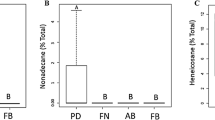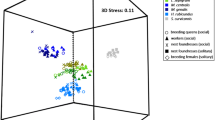Abstract
In honeybees, the cuticular hydrocarbon profiles are partly genetically based and differ between subfamilies, which suggests that they might be used by the workers as labels for subfamily recognition. This ability could potentially form the basis for nepotistic conflicts between subfamilies that would be detrimental to the inclusive fitness of the colony. Here we have compared the subfamily hydrocarbon profiles of 5-day-old workers maintained in isolation with those kept in their parental colony. We demonstrate that the cuticular hydrocarbon profiles tend to be less distant between most subfamilies within the hive compared with those held in isolation. The main consequence of this partial homogenization of the majority of subfamily signatures may result in a reduction of the number of recognizable subfamilies in the colony. Nevertheless, a few subfamilies retain very distinct cuticular hydrocarbon profiles.
Similar content being viewed by others
REFERENCES
Arnold, G., Quenet, B., Cornuet, J. M., Masson, C., De Schepper, B., Estoup, A., and Gasqui, P. 1996. Kin recognition in honeybees. Nature 379:498.
BagnÈres, A. G., Errard, C., Mulheim, C., Joulie, C., and Lange, C. 1991. Induced mimicry of colony odors in ants. J. Chem. Ecol. 17:1641-1664.
Bonavita-Cougourdan, A., Rivi Ère, G., Provost, E., BagnÈres, A. G., Roux, M., Dusticier, G., and ClÉment, J. L. 1996. Selective adaptation of the cuticular hydrocarbon profiles of the slave-making ants Polyergus rufescens and their Formica rufibarbis and F. cunicularia slaves. Comp. Biochem. Physiol. 113B:313-329.
Breed, M. D., Welch, C. K., and Cruz, R. 1994. Kin discrimination within honey bee colonies: an analysis of the evidence. Behav. Proc. 33:25-40.
Calderone, N. W., and Page, R. E. 1988. Genotypic variability in age polyethism and task specialization in the honey bee. Behav. Ecol. Sociobiol. 22:17-25.
Dahbi, A., and Lenoir, A. 1998. Nest separation and the dynamics of the Gestalt odor in the polydomous ant Cataglyphis iberica. Behav. Ecol. Sociobiol. 42:349-355.
Escofier, B., and Pages, J. 1982. Analyses Factorielles Simples et Multiples. Dunod, Paris.
Estoup, A., Solignac, M., and Cornuet, J. M. 1994. Precise assessment of the number of patrilines and of genetic relatedness in honeybee colonies. Proc. R. Soc. London B 258:1-7.
Francis, B. R., Blanton, W. E., Littlefield, J. L., and Nunamaker, R. A. 1989. Hydrocarbons of the cuticle and hemolymph of the adult honey bee. Ann. Entom. Soc. Am. 82:486-494.
Frumhoff, P. C. and Schneider, S. 1987. The social consequences of honey bee polyandry: The effects of kinship on worker interactions within colonies. Anim. Behav. 35:255-262.
Garnery, L., Vautrin, D., Cornuet, J. M., and Solignac, M. 1990. Phylogenetic relationships in the genus Apis inferred from mitochondrial DNA sequence data. Apidologie 22:87-92.
Getz, W. M., and Page, R. E. 1991. Chemosensory kin-communication systems and kin recognition in honey bees. Ethology 87:298-315.
Getz, W. M., and Smith, K. B. 1983. Genetic kin recognition: Honey bees discriminate between full and half sisters. Nature 302:147-148.
Getz, W. M., and Smith, K. B. 1987. Olfactory sensitivity and discrimination of mixtures in the honeybee. J. Comp. Physiol. A 160:239-245.
Howard, R. W. 1993. Cuticular hydrocarbons and chemical communication, pp. 179-226, in D. W. Stanley-Samuelson and D. R. Nelson (eds.). Insect Lipids: Chemistry, Biochemistry and Biology. University of Nebraska Press, Lincoln.
Keller, L. 1997. Indiscriminate altruism: unduly nice parents and siblings. TREE 12:99-103.
Mahalanobis, P. C. 1948. Historic note on the D2-statistic. Sankhya 9:237.
Manly, B. F. J. 1994. Multivariate Statistical Methods. Chapman & Hall, London.
Moritz, R. F. A., and Southwick, E. E. 1992. Bees as Superorganisms. Springer-Verlag, Berlin.
Nelson, D. R., and Blomquist, G. J. 1995. Insect waxes, pp. 1-90, in R. J. Hamilton and W. W. Christie (eds.). Waxes: Chemistry, Molecular Biology and Functions. The Oily Press Ltd., England.
Oldroyd, B. P., Rinderer, T. E., and Buco, S. M. 1991. Honey bees dance with their super-sisters. Anim. Behav. 42:121-129.
Oldroyd, B. P., Rinderer, T. E., Schwenke, J. R., and Buco, S. M. 1994. Subfamily recognition and task specialisation in honey bees. Behav. Ecol. Sociobiol. 34:169-173.
Page, R. E., Metcalf, R. A., Metcalf, R. L., Erickson, E. H., and Lampman, R. L. 1991. Extractable hydrocarbons and kin recognition in honeybee. J. Chem. Ecol. 17:745-756.
Ratnieks, F. L. W. 1991. The evolution of genetic odour-cue diversity in social Hymenoptera. Am. Nat. 137:202-226.
Ratnieks, F. L. W., and Reeve, H. K. 1992. Conflict in single-queen hymenopteran societies: The structure of conflict and processes that reduce conflict in advanced eusocial species. J. Theor. Biol. 158:33-65.
Tilley, C. A., and Oldroyd, B. P. 1997. Unequal subfamily proportions among honey bee queen and worker brood. Anim. Behav. 54:1483-1490.
Author information
Authors and Affiliations
Rights and permissions
About this article
Cite this article
Arnold, G., Quenet, B. & Masson, C. Influence of Social Environment on Genetically Based Subfamily Signature in the Honeybee. J Chem Ecol 26, 2321–2333 (2000). https://doi.org/10.1023/A:1005574810743
Issue Date:
DOI: https://doi.org/10.1023/A:1005574810743




